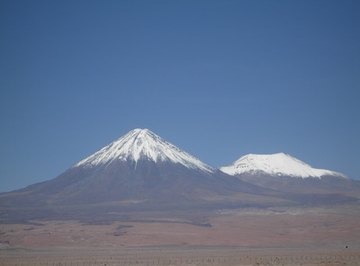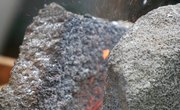
After an eruptive volcano explosion, volcanic cones are formed as a result of molten lava hardening when it confronts cooler temperatures. However, not all volcano eruptions are the same, which results in different forms of volcanic cones. Most volcanic cones are at the peaks of volcanic mountains, since that is where lava usually hardens. However, one type of volcanic cone, ash and tuft, produces a widespread ring of ashes around the mountain.
Cinder
These volcanic cones are composed of cinders, which are small rock fragments. Some of the rock fragments include pumice and tephra. Volcanoes with cinder cones are recognized by the bowl-shaped crater at the volcano's summit. This type of volcanic cone is formed when a single-vent volcano erupts and the ejected lava breaks into small pieces. Once the lava lands on the surface, it hardens into a rock fragment. Cinder cones are typically one of the smaller varieties of volcano cones in terms of height, with some growing up to 330 feet. Volcanoes with cinder cones include the Sunset Crater in northern Arizona and the summit of Mauna Kea mountain in Hawaii.
Spatter
Spatter volcano cones form when lava flows out of the volcanic hole and slides down the mountainside. The result is a steep hill with a conical shape. These types of volcanic cones are on volcanoes with lava primarily composed of fluids, which are common on the Hawaiian Islands. The name of spatter cones derives from the liquid rock produced by the lava, which is called “spatter.” Due to the fluidity of the lava, spatter cones usually have irregular shapes since the spatter will harden before it becomes a smooth surface. Contrary to other types of volcanic cones, though, spatter pieces will often meld with each other before they harden.
Ash and Tuff
The ash and tuff volcano cones form as a result of contact between lava and bodies of water with shallow depths. This distinguishes them from the cinder and spatter cones, which are created from the lava itself. When the lava and water make contact, it produces a steam. The mixture of the steam, lava and water make flurries of sand and stilt-like particles, also referred to as ash. When all of the ashes settle on the ground, it forms an ash cone. When the ash cone solidifies, an act of all the fallen ashes consolidating with one another, it is known as a tuff cone, or tuff ring. Examples of ash and tuff cones are on the Diamondhead peak in Honolulu, Hawaii, and the Kapaho Cone on Hawaii's Kilauea Volcano.
References
About the Author
Skip Davis has been writing professionally since 2005. His work has appeared in "Southern Literary Magazine," on various websites and in graphic panels at the Jackson Zoological Park in Jackson, Miss. Currently living in Southern California, Davis received his Bachelor of Arts in theater at Belhaven College.
Photo Credits
andean volcanoes image by rrruss from Fotolia.com
